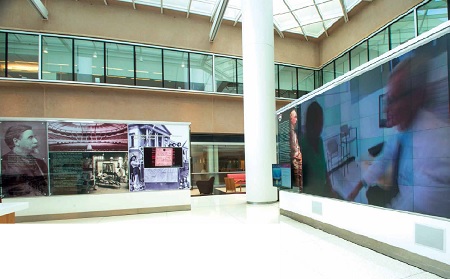

Ideally, AV supplies mission-critical, mission-driven infrastructure—ideally, intertwined with the goals of an organization. At the University of Pennsylvania’s Perelman School of Medicine, an enviable AV system makes it easier to teach, collaborate, and connect to partners internally and throughout the world. Not every organization has the luxury of Penn’s resources, by a long shot, but resources alone can’t do the job. It also takes foresight, as well as respect among collaborators. Too often that too is perceived as a luxury.
Less than a week before we went to press, students, alumni, donors, faculty, and leadership from the University of Pennsylvania and the Perelman School of Medicine gathered to celebrate the ribbon cutting for the Henry A. Jordan Medical Center (JMEC) at the Perelman School of Medicine. Jordan’s family was in the audience, for the event, which coincided with the 250th anniversary of Penn’s medical school. As the oldest medical school in the nation, it’s also among the most modern. Here, students study medicine the way they will practice it—which today means collaboratively and sometimes virtually.
The new 55,000 square-foot JMEC is a point of pride for Penn, named in recognition of devoted Perelman faculty member and alumnus Henry Jordan M’62, and in honor of his family, which helped make the center possible. Architecturally, it is designed for generous light, with a large atrium spanning one side of the center, on the 5th and 6th floors of the Perelman School of Advanced Medicine at the heart of Penn’s medical campus. It’s a welcoming, flexible, unifying, and connective environment—words that Penn sources say describe Henry Jordan himself.
With its combination of open space, and reconfigurable, wired classrooms, the new JMEC is a model for interconnected and collaborative learning. It is also the latest advancement for the medical center’s AV system, which has been some 20 years in the making, under the supervision of Charles Bears, director of Media Technology & Production, Penn Medicine. Over the course of this time, through an array of projects big and small, systems designer/integrator Advanced AV and AV consultant Cerami Associates have collaborated with their Penn client to optimize the potential of the entire medical school’s AV network. The result is uniquely flexible and efficient, and designed for maximum signal fidelity. It’s uncompressed and HD wherever possible—for example, doctors and students can observe surgeries and labs in enough HD detail to read flesh tones. At the same time, it’s nimble and compressed where necessary—the medical school can support rural and international communications as well as BYOD through a combination of hard and soft videoconferencing codecs.
The network supports an overarching curriculum and philosophy that has influenced the technical infrastructure for more than 15 years. Penn’s Gail Morrison, MD, who is senior vice dean for education and director of the Office of Academic Programs, has explained that Penn’s curriculum emphasizes flexibility, small group learning, and virtual coursework, including realtime virtual lectures and videoconferencing, and classrooms that can be adapted on the fly to huddle groups or large lectures. Nearly every live interaction is recorded to Penn’s extensive Sonic Foundry Mediasite-based system. As Morrison has explained, “Today, the technology lets us simulcast lectures from all over the world; we can share information easily, and instead of bringing the students to the dissection room, they can do the same work virtually in simulation centers where they can practice skills such as placing a central line and intubating patients.

The newest of three control rooms on the Penn Medicine campus allows techs to monitor every room and distribute almost unlimited sources anywhere on the network.
The Jordan Medical Education Center is the most recent execution of this technical strategy:
JMEC building features:
* One-and-a-half stories of space, bringing together all aspects of undergraduate medical education at Penn for the first time.
* Co-location with the latest outpatient and research facilities: The Perelman Center for Advanced Medicine and the Smilow Center for Translational Research.
* An ultra-high-tech auditorium, with seating capacity for an entire class, to be used for large lectures, CME courses, and events.
* At least 14 easily accessible wired spaces where students can gather—in assigned learning groups or for smaller ad hoc meetings—to discuss classroom work or clinical rotations.
* Two 3,000-square-foot flexible, technology- rich learning studios that can be converted into two 1,500-square-foot classrooms or four 750-square-foot rooms.
* Eight classrooms overlooking the Schuylkill River and the City of Philadelphia, providing students with space that can be configured for both small and large group work.
* More than 50 70in. high-definition televisions/ video monitors that will allow for content to be moved from one space to another, locally via Christie Brio, or over the single-mode fiber and/or Blue Jeans networks via a central control room.
FIBER IS THE BACKBONE

Local control racks for displays, projectors, audio, and screen sharing (Christie Brio) also source back to the control rooms and can access shared media assets.
Advanced AV, Cerami, and the client designed the network to serve educational functions across the range of Penn Medicine participants, including students, faculty, PhD candidates, and doctors. It supports medical education, physician training, and research collaboration.
The system comprises a robust single-mode fiber network, hard codec videoconferencing hardware, and cloud-based videoconferencing, plus centralized and portable media servers and other shared media production and distribution assets, including a future broadcast studio. As more classrooms and clinical facilities are built or remodeled (or as higher resolutions become available), it is relatively simple and cost effective to change transmitters, receivers, and end points to integrate the new rooms into the network. This, says Media Director Bears, was a key driver in the vision of the AV system to achieve long-term cost effectiveness and future proofing.
Each room has its own local system (including Christie Brio for screen sharing). However, the network allows additional media assets (sources and software) to be made available to any location at any time through one of three central control rooms—including the brand-new control room at JMEC. A small team of technicians, working out of these control rooms, can monitor every room in the system. They can reconfigure and reassign assets to accommodate a wide variety of live events and an almost unlimited combination of sources from across Penn Medicine and throughout the world.
Locally, the Penn Medicine AV network ties together the new JMEC, the nearby Smilow Center for Translational Research, and the anatomy/chemistry building, as well as operating rooms at Penn’s hospital and exam rooms at yet another location. HD images from Vaddio PowerVIEW HD-22 cameras as well as local audio in all these locations can be fed to all other locations over an Extron FOX fiber matrix with XTP routing, live or streamed via Sonic Foundry Mediasite servers. Communication over the fiber ring is bidirectional. For example, physicians gathered in the auditorium to watch a surgery going on in one of the hospital operating rooms can ask questions of the attending physician.
CAMPUS AND BEYOND
In addition to the fiber network, Penn Medicine’s media network is used to connect to visiting professors, other institutions, and rural and international doctors and students across the globe. Penn’s ability to take advantage of worldwide resources—and to share their own—is greatly enhanced by the network elements that enable this collaboration. Over the past several years, Advanced AV has helped them integrate hard codec videoconferencing, Mediasite streaming and VOD, and Blue Jeans soft codec videoconferencing. Director Bears further explains that modern research grants are nearly always collaborative and require that institutions have robust conferencing capabilities—another job for the Penn Medicine network.
Locally the Blue Jeans network is also part of supporting BYOD on campus, reflecting the understanding that today’s students and medical professionals will sometimes prioritize convenience, speed, and flexible access.
SIGNAL INTEGRITY
Advanced AV’s Eric Bixler says the ethos is to always use the best signal available. Locally, that might be fiber to deliver the most pristine diagnostic images to physicians. Where collaborating individuals or institutions have comparable Cisco or Polycom systems, that’s the preferred platform. And when it’s important to access the far reaches of the globe or places with limited bandwidth (or iDevice preferences), the Blue Jeans network takes that role.
But Bears emphasizes that in addition to the integrity of signal path, and the philosophy of providing quality centralized control, he also lives by the time-honored meme, “Garbage In, Garbage Out.” With his background in video production, he knows the importance of hiring technicians who understand signal quality and production first. They can always be trained on the classroom systems. He looks for people who know how to calibrate a camera, cut a piece of video, and balance an audio track. To illustrate just one reason why this is so important, he explains that, to a doctor, good color balance of flesh or tissue tones on a video image can be the difference in securing a diagnosis.
The signal quality philosophy also extends to the public spaces in JMEC, where a large Christie MicroTile LED wall presides. From the audio side, Biamp DSP (via Tesira server on an AVB network) ensures that the control room techs can deliver the most intelligible audio wherever it was needed. And in case you were wondering how they manage to maintain audio quality in a soaring atrium that is more than 50 percent glass, the nod goes to Renkus- Heinz steerable arrays.
PRODUCT AT WORK:
VADDIO AV BRIDGE CONFERENCE
The Vaddio AV Bridge Conference is a room-based HD media streaming solution enabling IP or USB streaming. It bridges the room’s video and analog audio into a computer (PC or Mac) or retrofits existing conference rooms by simply plugging a USB cable into a host PC or connecting to an IP network. It’s designed as an HD encoder with two-way analog audio to send the near-end audio to the far-end and return the far-end audio to the room’s pro mixer with AEC. It’s controllable with an embedded web server, and the current settings are viewable from the front-panel menu system. It accepts up to HD 1080p/60 in HDMI and YPbPr, including widescreen VESA-type PC resolutions (RGBHV or DVI). The USB streaming functions using MJPEG and standard UVC with UAC drivers. The IP streaming uses RTSP or HLS and encodes H.264 video with AAC Audio.
www.vaddio.com










